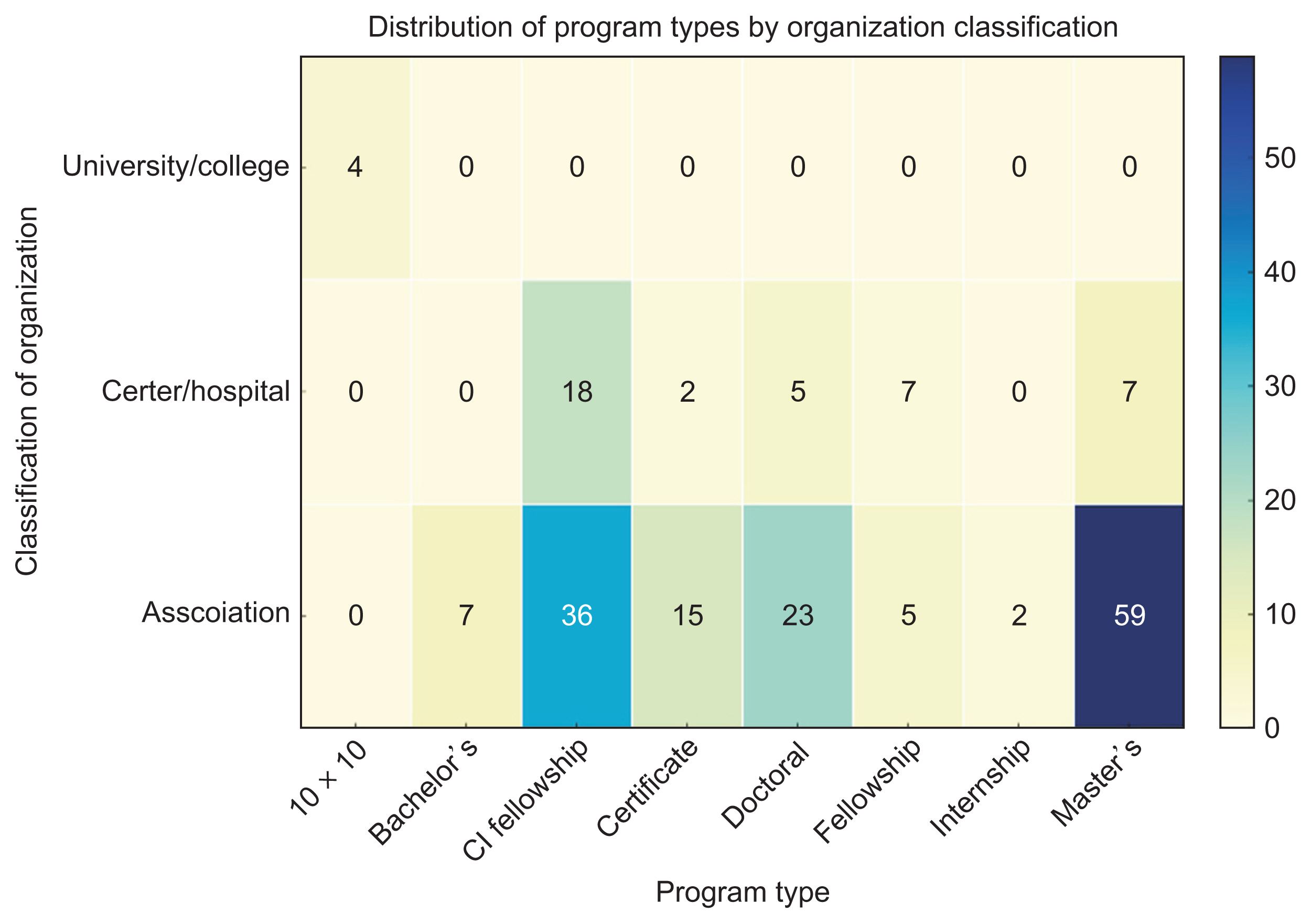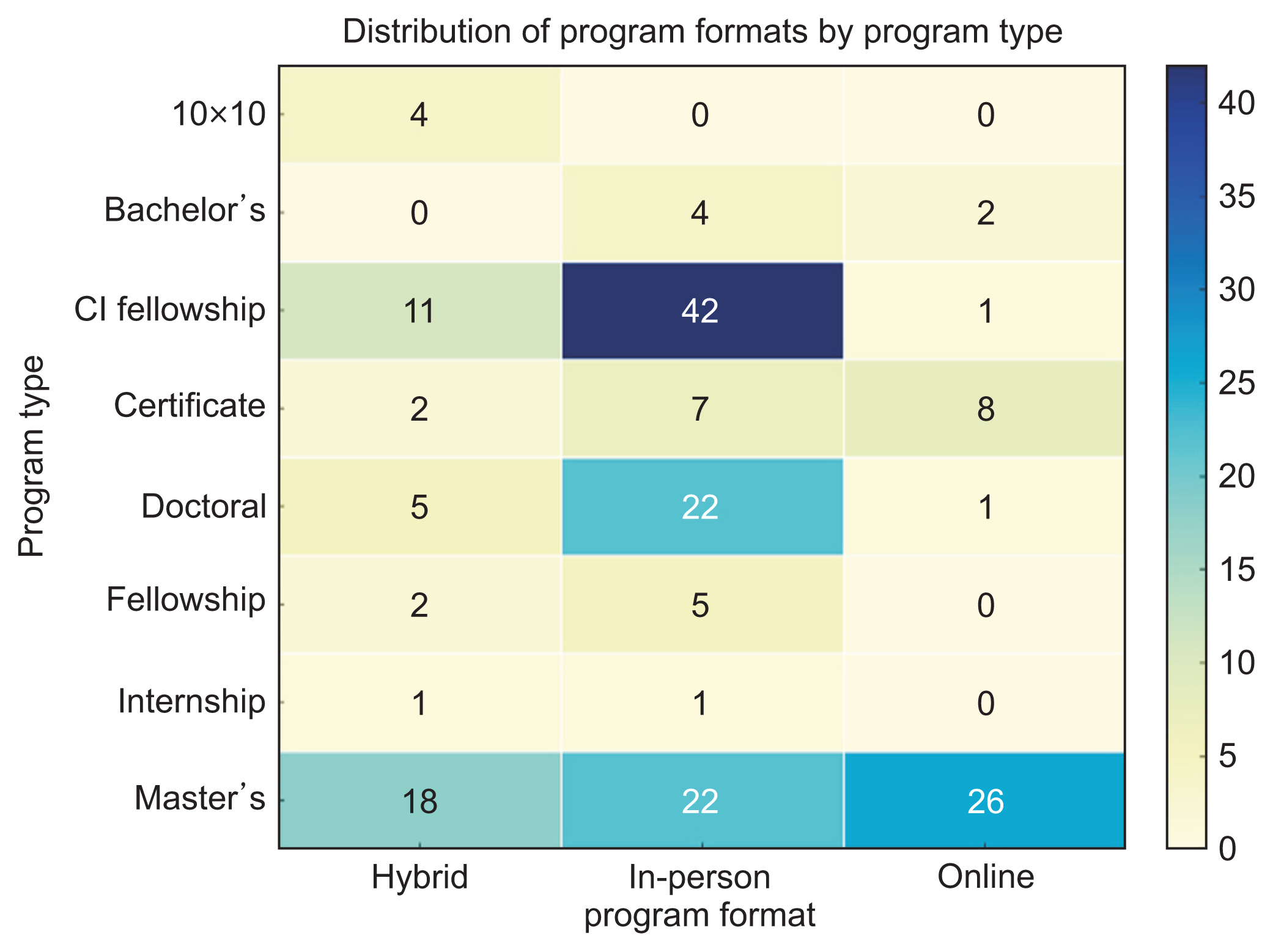Healthc Inform Res.
2024 Apr;30(2):113-126. 10.4258/hir.2024.30.2.113.
Empowering Healthcare through Comprehensive Informatics Education: The Status and Future of Biomedical and Health Informatics Education
- Affiliations
-
- 1Department of Biomedical Informatics, Asan Medical Center, University of Ulsan College of Medicine, Seoul, Korea
- 2Department of Biomedical Informatics, Graduate School of Medicine, CHA University, Seongnam, Korea
- 3Institute for Biomedical Informatics, Graduate School of Medicine, CHA University, Seongnam, Korea
- 4Department of Emergency Medicine, Asan Medical Center, University of Ulsan College of Medicine, Seoul, Korea
- 5Department of Nursing, College of Health and Welfare, Gangneung-Wonju National University, Wonju, Korea
- 6Department of Nursing, College of Medicine, Inha University, Incheon, Korea
- 7College of Nursing and Mo-Im Kim Nursing Research Institute, Yonsei University, Seoul, Korea
- 8College of Nursing, Chungnam National University, Daejeon, Korea
- KMID: 2555211
- DOI: http://doi.org/10.4258/hir.2024.30.2.113
Abstract
Objectives
Education in biomedical and health informatics is essential for managing complex healthcare systems, bridging the gap between healthcare and information technology, and adapting to the digital requirements of the healthcare industry. This review presents the current status of biomedical and health informatics education domestically and internationally and proposes recommendations for future development.
Methods
We analyzed evidence from reports and papers to explore global trends and international and domestic examples of education. The challenges and future strategies in Korea were also discussed based on the experts’ opinions.
Results
This review presents international recommendations for establishing education in biomedical and health informatics, as well as global examples at the undergraduate and graduate levels in medical and nursing education. It provides a thorough examination of the best practices, strategies, and competencies in informatics education. The review also assesses the current state of medical informatics and nursing informatics education in Korea. We highlight the challenges faced by academic institutions and conclude with a call to action for educators to enhance the preparation of professionals to effectively utilize technology in any healthcare setting.
Conclusions
To adapt to the digitalization of healthcare, systematic and continuous workforce development is essential. Future education should prioritize curriculum innovations and the establishment of integrated education programs, focusing not only on students but also on educators and all healthcare personnel in the field. Addressing these challenges requires collaboration among educational institutions, academic societies, government agencies, and international bodies dedicated to systematic and continuous workforce development.
Figure
Reference
-
References
1. Bichel-Findlay J, Koch S, Mantas J, Abdul SS, Al-Shorbaji N, Ammenwerth E, et al. Recommendations of the International Medical Informatics Association (IMIA) on education in biomedical and health informatics: second revision. Int J Med Inform. 2023; 170:104908. https://doi.org/10.1016/j.ijmedinf.2022.104908.
Article2. Khairat S, Feldman SS. Undergraduate health informatics education. Berner ES, editor. Informatics education in healthcare: lessons learned. Cham, Switzerland: Springer;2020. p. 75–84. https://doi.org/10.1007/978-3-030-53813-2_6.
Article3. World Health Organization. Digital education for building health workforce capacity [Internet]. Geneva, Switzerland: World Health Organization;2020. [cited at 2024 Apr 29]. Available from: https://www.who.int/publications/i/item/9789240000476.4. World Health Organization. Global strategy on human resources for health: Workforce 2030 [Internet]. Geneva, Switzerland: World Health Organization;2020. [cited at 2024 Apr 29]. Available from: https://www.who.int/publications/i/item/9789241511131.5. Wyatt JC, Liu JL. Basic concepts in medical informatics. Journal of Epidemiology & Community Health. 2002; 56(11):808–12. https://doi.org/10.1136/jech.56.11.808.
Article6. Masic I. Five periods in development of medical informatics. Acta Inform Med. 2014; 22(1):44–8. https://doi.org/10.5455/aim.2014.22.44-48.
Article7. Korean Society of Medical Informatics. Biomedical and health informatics. Seoul, Korea: Hyunmoon;2014.8. Delaney CW, Weaver CA, Sensmeier J, Pruinelli L, Weber P. Nursing and informatics for the 21st century: embracing a digital world (Book 2: Nursing education and digital health strategies). New York (NY):: Routledge;2022.9. International Medical Informatics Association. Recommendations of the International Medical Informatics Association (IMIA) on education in health and medical informatics. Methods Inf Med. 2000; 39(3):267–77. https://doi.org/10.1055/s-0038-1634340.10. Kulikowski CA, Shortliffe EH, Currie LM, Elkin PL, Hunter LE, Johnson TR, et al. AMIA board white paper: definition of biomedical informatics and specification of core competencies for graduate education in the discipline. J Am Med Inform Assoc. 2012; 19(6):931–8. https://doi.org/10.1136/amiajnl-2012-001053.
Article11. Hubner U, Shaw T, Thye J, Egbert N, Marin HF, Chang P, et al. Technology Informatics Guiding Education Reform: TIGER. Methods Inf Med. 2018; 57(S 01):e30–42. https://doi.org/10.3414/ME17-01-0155.
Article12. Khairat S, Feldman SS, Rana A, Faysel M, Purkayastha S, Scotch M, et al. Foundational domains and competencies for baccalaureate health informatics education. J Am Med Inform Assoc. 2023; 30(10):1599–607. https://doi.org/10.1093/jamia/ocad147.
Article13. American Association of Colleges of Nursing. The Essentials: core competencies for professional nursing education [Internet]. Washington (DC): American Association of Colleges of Nursing;2021. [cited 2024 Apr 29]. Available from: https://www.aacnnursing.org/Essentials/Domains/Informatics-andHealthcare-Technologies.14. Detmer DE, Lumpkin JR, Williamson JJ. Defining the medical subspecialty of clinical informatics. J Am Med Inform Assoc. 2009; 16(2):167–8. https://doi.org/10.1197/jamia.M3094.
Article15. Gardner RM, Overhage JM, Steen EB, Munger BS, Holmes JH, Williamson JJ, et al. Core content for the subspecialty of clinical informatics. J Am Med Inform Assoc. 2009; 16(2):153–7. https://doi.org/10.1197/jamia.M3045.
Article16. American Medical Informatics Association. AMIA 10×10 Virtual Courses [Internet]. Washington (DC): American Medical Informatics Association;c2024. [cited 2024 Apr 29]. Available from: https://amia.org/education-events/amia-10x10-virtual-courses.17. Tudor Car L, Kyaw BM, Nannan Panday RS, van der Kleij R, Chavannes N, Majeed A, et al. Digital health training programs for medical students: scoping review. JMIR Med Educ. 2021; 7(3):e28275. https://doi.org/10.2196/28275.
Article18. Jidkov L, Alexander M, Bark P, Williams JG, Kay J, Taylor P, et al. Health informatics competencies in postgraduate medical education and training in the UK: a mixed methods study. BMJ Open. 2019; 9(3):e025460. https://doi.org/10.1136/bmjopen-2018-025460.
Article19. Cummins MR, Sward K, Guo JW. Leaders in nursing informatics education and research: the University of Utah celebrates 25 years. Comput Inform Nurs. 2015; 33(9):379–81. https://doi.org/10.1097/01.NCN.0000471466.92959.90.
Article20. American Nurses Association. Nursing informatics: scope and standards of practice. 2nd ed. Silver Spring (MD): American Nurses Association;2015.21. Bove LA. Integration of informatics content in baccalaureate and graduate nursing education: an updated status report. Nurse Educ. 2020; 45(4):206–9. https://doi.org/10.1097/NNE.0000000000000734.
Article22. Canadian Association of Schools of Nursing. Nursing informatics teaching toolkit: supporting the integration of the CASN nursing informatics competencies into nursing curricula [Internet]. Ottawa, Canada: Canadian Association of Schools of Nursing;2013. [cited at 2014 Apr 29]. Available from: https://www.casn.ca/2014/12/nursing-informatics-teaching-toolkit/.23. Cummings E, Shin EH, Mather C, Hovenga E. Embedding nursing informatics education into an australian undergraduate nursing degree. Stud Health Technol Inform. 2016; 225:329–33. https://doi.org/10.3233/978-1-61499-658-3-329.
Article24. Health Informatics Society of Australia. Nursing informatics position statement (3 April 2017 Version 9) [Internet]. Melbourne, Australia: Health Informatics Society of Australia;2017. [cited at 2024 Apr 29]. Available from: https://www.hisa.org.au/wp-content/uploads/2017/04/NURSING-INFORMATICS-POSITION-STATEMENT_v.9-DRAFT.pdf?x97063.25. Australian College of Nursing. Leading digital health transformation: the value of Chief Nursing Information Officer (CNIO) roles [Internet]. Canberra, Australia: Australian College of Nursing;2019. [cited at 2024 Apr 29]. Available from: https://www.acn.edu.au/wp-content/uploads/position-statement-leading-digital-health-transformation-value-cnio-roles.pdf.26. Honey M, Collins E, Britnell S. Education into policy: embedding health informatics to prepare future nurses: New Zealand case study. JMIR Nurs. 2020; 3(1):e16186. https://doi.org/10.2196/16186.
Article27. Honey M, Collins E, Britnell S. Guidelines: Informatics for nurses entering practice [Internet]. Auckland, New Zealand: Auckland University of Technology;2018. [cited at 2024 Apr 29]. Available from: https://doi.org/10.17608/k6.auckland.7273037.
Article28. Mantas J. Developing curriculum in nursing informatics in Europe. Int J Med Inform. 1998; 50(1–3):123–32. https://doi.org/10.1016/s1386-5056(98)00059-8.
Article29. Shobuzawa S, Endo Y, Yamanouchi K. Availability of nursing informatics education for master’s programs in nursing administration at graduate schools of nursing in Japan. Stud Health Technol Inform. 2021; 284:44–6. https://doi.org/10.3233/SHTI210660.
Article30. Kolokathi A, Hasman A, Chronaki C, Madsen I, Moen A, Randell R, et al. Education in biomedical and health informatics: a European perspective. Stud Health Technol Inform. 2019; 264:1951–2. https://doi.org/10.3233/SHTI190729.
Article31. National Academy of Medicine. National Academies of Sciences, Engineering, and Medicine; Committee on the Future of Nursing 2020–2030. The future of nursing 2020–2030 charting a path to achieve health equity. Washington (DC): National Academic Press;2021. https://doi.org/10.17226/25982.32. Muller T. Information technology and eHealth to improve patient safety. Internist (Berl). 2020; 61(5):460–9. https://doi.org/10.1007/s00108-020-00780-6.
Article33. Elite Learning. Nursing informatics: a career on the rise [Internet]. Ormond Beach (FL): Elite Learning;2023. [cited at 2023 Apr 29]. Available from: https://www.elitelearning.com/resource-center/nursing/nursing-informatics-a-career-on-the-rise/.34. Zippia. Informatics nurse overview [Internet]. Miami (FL): Zippia Inc;c2024. [cited at 2024 Apr 29]. Available from: https://www.zippia.com/informatics-nurse-jobs/.35. Healthcare Information and Management Systems Society (HIMSS). 2020 Nursing Informatics Workforce Survey [Internet]. Chicago (IL): HIMSS;2020. [cited at 2024 Apr 29]. Available from: https://www.himss.org/sites/hde/files/media/file/2020/05/15/himss_nursing-informaticssurvey2020_v4.pdf.36. Kim JH. Certification for physicians in biomedical informatics. Healthc Inform Res. 2013; 19(1):1–2. https://doi.org/10.4258/hir.2013.19.1.1.
Article37. Park HA, Kim JE, Yang YH, Hyun SY. A survey study of nursing informatics education in Korea. J Korean Soc Med Inform. 1999; 5(1):11–25. https://doi.org/10.4258/jksmi.1999.5.1.11.
Article38. Yom YH, Kim JE, Chun BC, Choi S, Whang DH, Park KM, et al. Development of standardized and competency-based curriculum in nursing informatics. J Korean Soc Med Inform. 2007; 13(3):227–36. https://doi.org/10.4258/jksmi.2007.13.3.227.
Article39. Jeon E, Kim J, Park HA, Lee JH, Kim J, Jin M, et al. Current status of nursing informatics education in Korea. Healthc Inform Res. 2016; 22(2):142–50. https://doi.org/10.4258/hir.2016.22.2.142.
Article40. Park M, Dlamini BB, Kim J, Kwak MJ, Cho I, Choi M, et al. Development of a standardized curriculum for nursing informatics in Korea. Healthc Inform Res. 2022; 28(4):343–54. https://doi.org/10.4258/hir.2022.28.4.343.
Article41. Korean Society of Medical Informatics. Nursing Informatics Special Working Group Nursing Education TFT: program outcome based nursing informatics curriculum [Internet]. Seoul, Korea: Korean Society of Medical Informatics;2022. [cited at 2024 Apr 29]. Available from: https://www.kosmi.org/bbs/board.php?bo_table=sub7_1&wr_id=738&sfl=wr_subject&stx=%EA%B0%84%ED%98%B8%EC%A0%95%EB%B3%B4%ED%95%99&sop=and.42. Senbekov M, Saliev T, Bukeyeva Z, Almabayeva A, Zhanaliyeva M, Aitenova N, et al. The recent progress and applications of digital technologies in healthcare: a review. Int J Telemed Appl. 2020; 2020:8830200. https://doi.org/10.1155/2020/8830200.
Article43. Luna D, Almerares A, Mayan JC 3rd, Gonzalez Bernaldo de Quiros F, Otero C. Health informatics in developing countries: going beyond pilot practices to sustainable implementations: a review of the current challenges. Healthc Inform Res. 2014; 20(1):3–10. https://doi.org/10.4258/hir.2014.20.1.3.
Article44. van Kessel R, Wong BL, Clemens T, Brand H. Digital health literacy as a super determinant of health: more than simply the sum of its parts. Internet Interv. 2022; 27:100500. https://doi.org/10.1016/j.invent.2022.100500.
Article45. Kerasidou A. Artificial intelligence and the ongoing need for empathy, compassion and trust in healthcare. Bull World Health Organ. 2020; 98(4):245–50. https://doi.org/10.2471/BLT.19.237198.
Article46. Abernethy A, Adams L, Barrett M, Bechtel C, Brennan P, Butte A, et al. The promise of digital health: then, now, and the future. NAM Perspect. 2022; 2022:202206e. https://doi.org/10.31478/202206e.
Article47. Buja LM. Medical education today: all that glitters is not gold. BMC Med Educ. 2019; 19(1):110. https://doi.org/10.1186/s12909-019-1535-9.
Article48. Bohr A, Memarzadeh K The rise of artificial intelligence in healthcare applications In: Artificial Intelligence in healthcare. London, UK: Academic Press;2020. 25–60. https://doi.org/10.1016/B978-0-12-818438-7.00002-2.49. Staggers N, Gassert CA, Curran C. Informatics competencies for nurses at four levels of practice. J Nurs Educ. 2001; 40(7):303–16. https://doi.org/10.3928/0148-4834-20011001-05.
Article50. Korean Accreditation Board of Nursing Education. Program outcome for nursing education [Internet]. Seoul, Korea: Korean Accreditation Board of Nursing Education;2021. [cited at 2024 Apr 29]. Available from: http://old.kabone.or.kr/HyAdmin/upload/good-File/120211126101506.pdf.
- Full Text Links
- Actions
-
Cited
- CITED
-
- Close
- Share
- Similar articles
-
- Recent Movement on Education and Training in Health Informatics
- Health Avatar: An Informatics Platform for Personal and Private Big Data
- Contents and Methodologies of Medical Informatics Education
- Value-Based Health Technology Assessment and Health Informatics
- Sharing Clinical Big Data While Protecting Confidentiality and Security: Observational Health Data Sciences and Informatics



